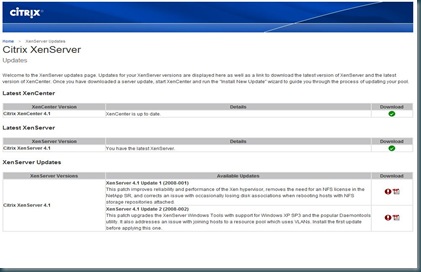I've been playing with the XenServer 4.1 product on a low end spare server I have laying around. To it's credit XenServer is the only one the big three hypervisors that will run on this Pentium D 820 server, as Hyper-V requires DEP, 64bit and processor side virtualization, and ESX3i requires specific approved hardware to function. Granted, without the processor virtualization assistance, XenServer is limited to deploying Linux guests only, it's still enough to be able to play with the interface and deploy some basic machines.
While not a complex and deep as VMware Update Manager, I am impressed with Citrix's simple "just the servers" approach to patching. While we are deploying VMware Update Manager to handle the ESX hosts, I can't see us ever using the guest patching capabilities, nor could I see any large organization doing so. In my opinion , most large IT shops won't want to maintain a separate update process for virtual machines and a separate update process for physical machines, despite the ability to roll back changes and other benefits of VMware Update Manager.
One of the best features of Citrix's product is their "Check For Updates" launcher. It gives you a clear view of what updates you already have, and which updates you should apply. Along with the download links are links to the patch notes. While it is much more rudimentary than VMware Update Manager, I appreciate the simplicity.
The Citrix patching utilities obviously don't compare with VMware Update Manager, but they certainly have the advantage over the VMware patching website. :
I found the deployment of the updates once they were downloaded to be incredibly simple, and the updater to be intelligent when it came to evaluating the server receiving the patches. It first attempted to evaluate moving the guest to another host, which was impeded by the fact I only have one server. Once it realized there were no migration options, it suspended the VM while applying the update and rebooting. After communication was re-established with XenCenter, the guest was resumed automatically. End to end, a pretty simple and intelligent process.
I hope VMware and Citrix (as well as Microsoft) are learning from each other, and improving their products based on their competitors strengths and weaknesses. I would like to see VMware implement a "simple" host updater into a future version of VirtualCenter. I will also be watching to see if XenCenter implements some of the more advanced features of VMware Update Manager directly into XenCenter.





